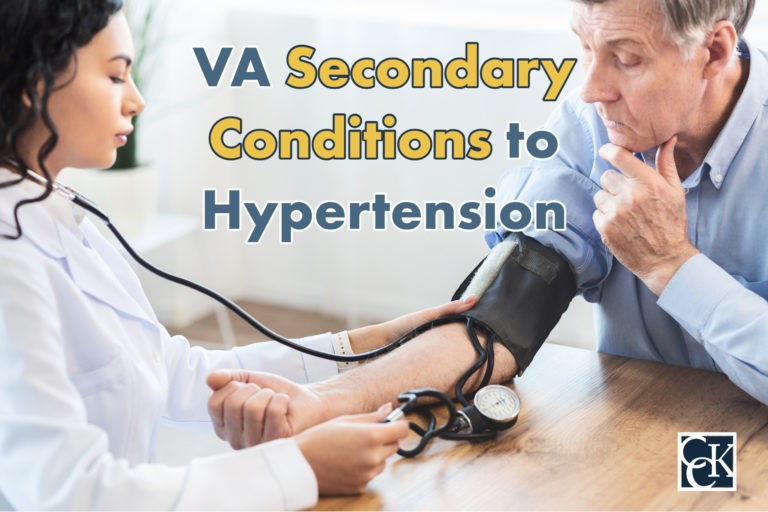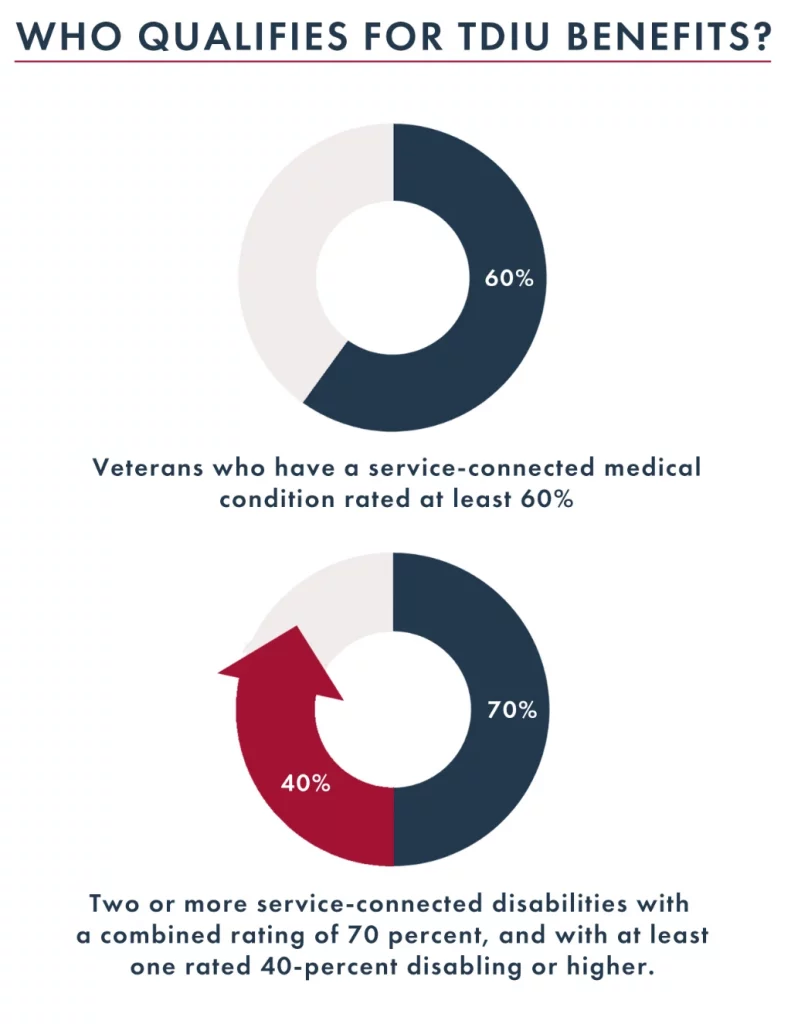VA Secondary Conditions to Hypertension

CCK Law: Our Vital Role in Veterans Law
What Is Hypertension?
Hypertension, also known as high blood pressure, is a very common condition among adults in the United States, with 47 percent of all adults affected.
According to the Centers for Disease Control and Prevention (CDC), blood pressure is the pressure of blood pushing against the walls of arteries. It is measured using:
- Systolic blood pressure – measures the pressure in arteries when the heart beats; and
- Diastolic blood pressure – measures the pressure in arteries when the heart rests between beats.
Generally, a normal blood pressure level is less than 120 systolic and 80 diastolic. High blood pressure, which is defined by a systolic blood pressure greater than 130 mmHg or a diastolic blood pressure greater than 80 mmHg, places people at a higher risk for other health issues, such as heart disease, a heart attack, or a stroke.
Causes and Risk Factors
Hypertension is usually caused by unhealthy lifestyle choices, such as physical inactivity or a poor diet. However, other conditions, including diabetes and obesity, can also increase the likelihood of hypertension.
Hypertension typically has no warning signs or symptoms, and many people may be unaware that they have developed the condition. Hypertension can usually only be diagnosed by measuring blood pressure.
Treatments
In some cases, people can lower their blood pressure into a healthy range through lifestyle changes, such as getting 150 minutes of physical activity per week, quitting smoking, limiting sodium and alcohol, and managing stress. However, some need to take medicine to manage their high blood pressure.
Medications for hypertension include thiazide diuretics, angiotensin-converting enzyme (ACE) inhibitors, and calcium channel blockers.
Hypertension and Veterans
Studies conducted by the Department of Veterans Affairs (VA) and other government agencies show a strong correlation between veterans and hypertension. According to VA, hypertension is the most common chronic condition among veterans, affecting more than 37 percent of the population.
The National Library of Medicine also published a study showing that combat exposure increases hypertension risk.

VA Ratings for Hypertension
For disability compensation purposes, VA defines hypertension as 90 or higher for diastolic and 160 or higher for systolic. Specifically, VA uses the rating criteria under 38 CFR § 4.104 – Schedule of Ratings, Cardiovascular System, diagnostic code 7101.
The diastolic and systolic measurements for each hypertension VA rating are as follows:
- 60 percent – diastolic pressure predominantly 130 or more.
- 40 percent – diastolic pressure predominantly 120 or more.
- 20 percent – diastolic pressure predominantly 110 or more; or systolic pressure predominantly 200 or more.
- 10 percent – diastolic pressure predominantly 100 or more; or systolic pressure predominantly 160 or more; or minimum evaluation for an individual with a history of diastolic pressure predominantly 100 or more who requires continuous medication for control.
How to Establish Secondary Service Connection
A secondary condition is a disability that resulted from an already service-connected condition. In claims for secondary service connection, it is essential to provide a nexus connecting the secondary condition to the primary service-connected disability.
In the case of conditions secondary to hypertension, veterans typically must have:
- A current diagnosis of a secondary condition by a medical professional; and
- A medical nexus linking the secondary condition to the service-connected hypertension.
When filing a claim for secondary service connection, veterans can use VA Form 21-526EZ.
Common VA Secondary Conditions to Hypertension
There are several VA secondary conditions commonly associated with hypertension, including ischemic heart disease, kidney disease, and stroke. If you are service connected for hypertension and later develop one of these conditions as a result, you may qualify for VA disability benefits based on secondary service connection.
Ischemic Heart Disease Secondary to Hypertension
Ischemic heart disease, also known as coronary artery disease (CAD), occurs when heart arteries narrow and less blood and oxygen reach the heart muscle, leading to a buildup of cholesterol plaque in the arteries. Hypertension is major risk factor for ischemic heart disease.
VA rates ischemic heart disease under 38 CFR § 4.104 – Schedule of Ratings, Cardiovascular System, diagnostic code 7005. Ischemic heart disease is typically assigned a disability rating of 10, 30, 60, or 100 percent depending on the severity.
Kidney Disease Secondary to Hypertension
Kidney disease often occurs when another condition or disability, such as hypertension, damages the kidneys over time. There are several types of kidney disease, including acute kidney failure, diabetic nephropathy, chronic kidney disease, and end-stage renal failure.
VA typically rates kidney disease under 38 CFR § 4.115a, Ratings of the Genitourinary System, using the criteria for renal dysfunction. Kidney disease may be rated at a 0, 30, 60, 80, or 100 percent depending on the type and severity of symptoms.
Stroke Secondary to Hypertension
A stroke occurs when blood flow to an area of the brain is cut off or reduced, depriving its tissue of necessary oxygen and nutrients. This can be caused by a blood clot obstructing the flow of blood to the brain, or by a blood vessel rupturing and preventing the flow of blood to the brain. Hypertension is one of the most common risk factors for certain types of stroke.
Veterans who experience a stroke due to their military service are usually assigned a temporary and total disability rating for six months following their final treatment. Veterans may also continue to receive compensation for any residual symptoms.

TDIU and Conditions Secondary to Hypertension
Secondary conditions can boost a veteran’s overall combined disability rating, and a higher combined rating can help a veteran meet the requirements for TDIU.
TDIU, or total disability based on individual unemployability, is a monthly VA benefit that compensates veterans at the 100 percent level. Veterans who are unable to obtain or maintain substantially gainful employment due to their service-connected condition(s) may qualify for TDIU. They must also meet the following criteria under 38 CFR § 4.16(a):
- The veteran must have a service-connected condition rated at least 60 percent; or
- A combined rating of at least 70 percent, with one condition rated 40 percent or more.
Veterans who do not meet these rating percentage criteria may be able to qualify for TDIU on an extraschedular basis through 38 CFR § 4.16(b).

Was Your Claim for Secondary Service Connection Denied?
If VA denied your claim for secondary service connection or any other claim for benefits, CCK may be able to help. The accredited attorneys and claims agents at Chisholm Chisholm & Kilpatrick have decades of experience successfully representing veterans and their families before the Department of Veterans Affairs, the Board of Veterans’ Appeals, and the Court of Appeals for Veterans Claims. Call CCK today at 800-544-9144 to speak with a member of our team.
About the Author
Share this Post
